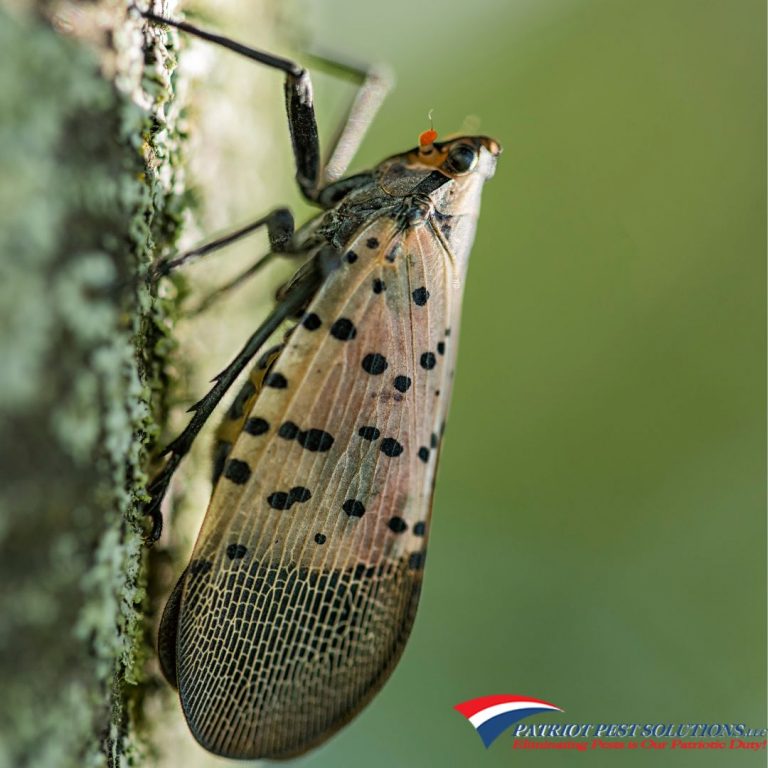The presence of spotted lanternflies in Pennsylvania has become a growing concern due to the significant impact these invasive pests have on the local ecosystem and agricultural industry. With their distinctive appearance and destructive feeding habits, the spotted lanternfly (Lycorma delicatula) has quickly become a cause for alarm among farmers, arborists, and environmentalists alike.
The spotted lanternfly, originally from Asia, was first identified in Pennsylvania in 2014. Since then, their population has exploded, leading to the classification of this pest as a serious threat to the state’s agriculture. Pennsylvania’s ideal climate and abundance of host plants have provided the perfect breeding ground for these invasive insects.
Description of Spotted Lanternflies
Spotted lanternflies are visually striking insects. They have a wingspan of about one inch and display vibrant colors. Their forewings are grayish with black spots, while their hind wings are red with black spots and patches of white. In their nymph stage, they are black with white spots, gradually transitioning into their adult form.
The life cycle of spotted lanternflies consists of four stages: egg, nymph, adult, and egg-laying adult. They lay their eggs in the fall on various surfaces such as trees, stones, or outdoor furniture. In spring, the nymphs hatch and begin to feed on the sap of plants, primarily targeting trees such as maples, willows, and fruit trees.
Spread and Impact in Pennsylvania
The rapid spread of spotted lanternflies can be attributed to various factors. The insects are excellent hitchhikers and can easily attach themselves to vehicles, outdoor furniture, or other objects, inadvertently facilitating their dispersal. The lack of natural predators in the region further exacerbates their population growth.
The impact of spotted lanternflies in Pennsylvania is significant and far-reaching. The agricultural industry, especially grape growers, has suffered substantial economic losses. The pests feed on grapevines, causing reduced yields and even vineyard mortality. Additionally, fruit trees, such as apple and peach trees, are also susceptible to damage.
Moreover, spotted lanternflies pose a threat to the environment. They have a voracious appetite and feed on a wide range of plants, leading to the decline of native species and disrupting the delicate balance of ecosystems.
Identification and Signs of Infestation
Identifying spotted lanternflies is crucial for effective management. The adults are most active from spring to fall and can be easily recognized by their distinct appearance. Their grayish forewings with black spots and red hind wings with black spots and patches of white are a telltale sign.
Signs of infestation include the presence of egg masses, which are brownish-gray, mud-like formations usually found on tree trunks, rocks, or other outdoor surfaces. These egg masses contain 30-50 eggs each and are a key indicator of potential infestation.
Another sign of spotted lanternfly infestation is the presence of nymphs and adults feeding on plants. They excrete a sticky substance called honeydew, which can attract ants and wasps. Black sooty mold often develops on plants where honeydew accumulates, further indicating the presence of these pests.
Damage Caused by Spotted Lanternflies
Spotted lanternflies can cause extensive damage to agricultural crops and the environment. Grape growers have experienced significant losses, as these pests feed on grapevines and weaken them, making them more susceptible to diseases. Reduced grape yields and poor-quality fruit have had severe economic consequences for vineyards in Pennsylvania.
Fruit trees, including apple, peach, and cherry trees, are also at risk. Spotted lanternflies puncture the bark and feed on the sap, causing stress to the trees and reducing their ability to produce healthy fruit. In severe cases, repeated infestations can lead to tree decline and even death.
The impact on the environment is equally concerning. Spotted lanternflies are known to feed on over 70 different plant species, including hardwood trees. This threatens the biodiversity of forests and disrupts the natural ecosystem. Native plants, which are essential for supporting local wildlife, are gradually being replaced by invasive species.
Controlling and Managing Spotted Lanternflies
Efforts to control and manage spotted lanternflies have focused on Integrated Pest Management (IPM) techniques. This approach combines various strategies to minimize the use of chemical pesticides while effectively reducing pest populations.
One method involves the use of insecticides targeted at specific life stages of the spotted lanternfly. Careful timing and application of these insecticides can help control the population. However, it is essential to follow instructions and regulations regarding their use to prevent harm to beneficial insects and the environment.
Biological control measures are also being explored. Natural enemies of the spotted lanternfly, such as predatory insects and parasitic wasps, are being studied for their potential in controlling the pest’s population. Ongoing research aims to identify and introduce effective biological controls without causing harm to non-target species.
Regulatory Measures and Public Awareness
To combat the spread of spotted lanternflies, regulatory measures and quarantine efforts have been implemented in affected areas. The Pennsylvania Department of Agriculture has established quarantine zones to limit the movement of items that could harbor these pests, such as firewood, outdoor furniture, and certain types of plants.
Public awareness plays a crucial role in controlling the spread of spotted lanternflies. Education campaigns are in place to inform the public about the identification, reporting, and prevention of infestations. Encouraging individuals to report sightings helps authorities track the spread of the pests and take appropriate action.
Steps for Homeowners and Businesses
Homeowners and businesses can take proactive steps to prevent the infestation of spotted lanternflies. Some best practices include:
- Inspecting outdoor items and furniture for egg masses or live insects before moving them.
- Removing tree bands or scraping off egg masses carefully and disposing of them properly.
- Pruning and destroying Ailanthus altissima, commonly known as the Tree of Heaven, as it is a preferred host plant.
- Using sticky traps or barriers on trees to catch nymphs and adults.
- Contacting local extension offices or pest control professionals for guidance and assistance.


